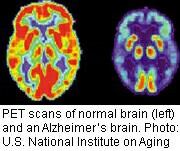- Double Mastectomy May Offer No Survival Benefit to Women With Breast Cancer
- Toxic Lead Found in Cinnamon Product, FDA Says
- Certain Abbott Blood Sugar Monitors May Give Incorrect Readings
- Athletes Can Expect High Ozone, Pollen Counts for Paris Olympics
- Fake Oxycontin Pills Widespread and Potentially Deadly: Report
- Shingles Vaccine Could Lower Dementia Risk
- Your Odds for Accidental Gun Death Rise Greatly in Certain States
- Kids From Poorer Families Less Likely to Survive Cancer
- Tough Workouts Won’t Trigger Cardiac Arrest in Folks With Long QT Syndrome
- At-Home Colon Cancer Test Can Save Lives
Fluorescent Scans May Have Potential to Track Alzheimer’s Progression


WEDNESDAY, Sept. 18Newly developed fluorescent compounds may help doctors track Alzheimer’s disease as it advances in living patients, a new study reveals.
Tests showed that these compounds highlighted so-called tau protein clusters on PET scans of the brains of people with Alzheimer’s disease.
The study was published in the Sept. 18 issue of the journal Neuron.
In the brains of Alzheimer’s disease patients, tau proteins clump together and become tangled. These tau tangles are an important marker of brain deterioration in people with the disease. Until now, it was difficult to monitor tau tangles while patients are still alive.
These new fluorescent compounds may help doctors track the processes that occur in the brain during the development and progression of Alzheimer’s disease, according to a journal news release.
This ability could prove helpful in diagnosing the disease, monitoring the effectiveness of treatments, and testing new drugs to prevent and treat the disease, according to study senior author Dr. Makoto Higuchi, of the National Institute of Radiological Sciences in Japan, and colleagues.
Tau tangles also play a role in other types of dementias and movement disorders. These new fluorescent compounds could also help doctors diagnose, monitor and treat these diseases, the researchers noted.
Another protein called amyloid beta accumulates into plaques in the brains of people with Alzheimer’s disease. Imaging technologies have been developed to observe the spread of amyloid beta plaques in patients’ brains.
More information
The U.S. National Institute on Aging has more about Alzheimer’s disease.
Source: HealthDay
Copyright © 2024 HealthDay. All rights reserved.










